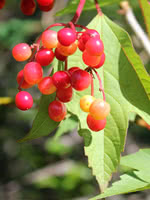Mon-Fri 9am - 5pm Mountain time
Highbush Cranberry vs Bilberry
Vaccinium myrtillus
Viburnum trilobum
CUSTOM GROW
NOT AVAILABLE THIS SEASON - MIGHT RETURN
(new stock expected: fall of 2027)
Bilberry is a native perennial shrub valued for its small, blue-black berries that ripen in mid to late summer. The berries resemble blueberries but have a richer, more tart, and intense flavor. They have long been used for fresh eating, baking, and preserves, while also providing food for birds and mammals. In spring, its delicate pinkish flowers attract bees and other pollinators.
Growing low to the ground, Bilberry forms spreading colonies that create dense understory cover. This growth habit provides food and shelter for wildlife, and its foliage adds seasonal interest by turning red to purple in autumn. With its adaptability and ecological benefits, Bilberry is well-suited for naturalization, ecological restoration, and pollinator gardens.
Highbush Cranberry produces attractive white flowers in late June and bears edible fruit that matures to a bright red colour in the late summer.
This shrub, native to much of Canada, is fast growing, and its fruit can be eaten raw or cooked into a sauce.
Bilberry Quick Facts
Highbush Cranberry Quick Facts
Toxicity: leaves may be unsafe in high doses
In row spacing: 0.6 m (2.0 ft)

